2011 年专业英语八级考试真题及答案
PART I
LISTENING COMPREHENSION
SECTION A
MINI-LECTURE
In this section you will hear a mini-lecture. You will hear the lecture ONCE ONLY.
While listening, take notes on the important points. Your notes will not be marked,
but you will need them to complete a gap-filling task after the mini-lecture. When
the lecture is over, you will be given two minutes to check your notes, and another
ten minutes to complete the gap-filling task on ANSWER SHEET ONE. Some of the gaps
may require a maximum of THREE words. Make sure the word(s) you fill in is (are)
both grammatically and semantically acceptable. You may refer to your notes while
completing the task. Use the blank sheet for note-taking.
Now, listen to the mini-lecture.
Classifications of Cultures
According to Edward Hall, different cultures result in different ideas about the
world. Hall is an anthropologist. He is interested in relations between cultures.
I. High-context culture
A. feature
- context: more important than the message
- meaning: (1)__________
i.e. more attention paid to (2) ___________ than to the message itself
B. examples
- personal space
- preference for (3)__________
- less respect for privacy / personal space
- attention to (4)___________
- concept of time
- belief in (5)____________ interpretation of time
- no concern for punctuality
- no control over time
II. Low-context culture
A. feature
- message: separate from context
- meaning: (6)___________
B. examples
- personal space
- desire / respect for individuality / privacy
- less attention to body language
- more concern for (7)___________
- attitude toward time
- concept of time: (8)____________
- dislike of (9)_____________
�
- time seen as commodity
III. Conclusion
Awareness of different cultural assumptions
- relevance in work and life
e.g. business, negotiation, etc.
- (10)_____________ in successful communication
参考答案:
(1) context of message
(2) what's happening / the context
(3) closeness to people
(4) body language
(5) poly-chronic
(6) message itself
(7) the message
(8) mono-chronic
(9) lateness
(10) great influence / significance
TIPS:
(1) 根据原文中一句“A high-context culture is a culture in which the context of the
message, or the action, or an event carries a large part of its meaning and
significance.”可知答案。
(2) 根据原文“What this means is that in a high-context culture, more attention is
paid to what's happening in and around the message than to the message itself.”
可知答案。
(3) 根据原文“Generally speaking, in a high-context culture, because this greater
dependency on group thinking, people lean towards heavier sense of involvement or
closeness to people.”可得出答案。
(4) 根据原文“And also people from a high-context culture pay attention to body
language.”可得出答案。
(5) 根据原文“People in high-context cultures, are considered to have, what is called
a poly-chronic attitude toward time.”可得出答案。
(6) 根据原文“A low-context culture is one in which the message, the event or the
action is a separate entity, having meaning onto itself, regardless of the
surroundings or the context.”可得出答案。
(7) 根据原文“And you'll also see that people might pay less attention to body
language, because as I said, the message is, the message is everything.”可得出
答案。
(8) 原文提到在 low-context culture 中,人们对时间的态度可称为 mono-chronic。
(9) 根据原文“People in a low-context culture would be much more upset with lateness,
because they feel that everyone should follow the same time.”可得出答案。
(10) 根据文章末尾部分“If you're in business, negotiations, interpersonal relations,
if you're dealing with people from different cultures in any way, it's going to affect
�
every part of your life. In any multi-cultural situation, these assumptions need
to be taken into account for successful interactions.”可知,在商务活动、谈判、
人际交往中,与来自不同文化的人打交道时,这些想法对成功的交际起着非常重要的作用。
script:
Classifications of Cultures
Good morning, everyone! Today, we'll look at culture or rather classifications of
cultures. Usually, when we deal with different people, we deal with them as if we
were all members of the same culture. However, it's possible that people from
different cultures have different assumptions about the world. We got in such
important and basic ideas as time, personal space. And this is the view of Edward
Hall. And Edward Hall is an anthropologist who spent a large part of his life studying
American Indians, their culture, their language. But he was different from a lot
of other anthropologists who just study one culture. He was interested in the
relations between cultures, how cultures interact. What Hall believes is that
cultures can be classified by placing them on a continuum, ranging from what he called
high-context to low-context.
OK, what is a high-context culture? A high-context culture is a culture in which
the context of the message, or the action, or an event carries a large part of its
meaning and significance. What this means is that in a high-context culture, more
attention is paid to what's happening in and around the message than to the message
itself.
Now, let me give you examples. First, in terms of personal space. Generally speaking,
in a high-context culture, because this greater dependency on group thinking, people
lean towards heavier sense of involvement or closeness to people. And they have less
respect for privacy, for personal space. If you go into that culture, people might
stand closer when they're talking to you. They might touch more. And if they're
jostled in a crowd, they won't feel violated. And also people from a high-context
culture pay attention to body language. Because remember what I said, the definition
of a high-context culture is that more attention is paid to the context of the message
than to the message itself. And part of the context is body language.
Second, in terms of time. People in high-context cultures, are considered to have,
what is called a poly-chronic attitude toward time. Here, "poly" means multiple and
"chronic" means time. What this means is that they believe people, things, events
have their own time. And there can't be a standard system of time for everything.
What this leads them to believe is that you can't emphasize punctuality. Things
happen when they are supposed to happen. So, there's a different attitude toward
time; there's no set standard of time; you can't control time; everything has its
own sense of time. So it's a culture that pays little attention to time, to clock
time.
Now, let's move on to low-context culture. A low-context culture is just the opposite.
A low-context culture is one in which the message, the event or the action is a
separate entity, having meaning onto itself, regardless of the surroundings or the
�
context. That the message, the event, the action has meaning in itself. So what this
means in a low-context culture, is that people pay more attention to the event itself
rather than to the context which surrounds the event or the message. For example,
in terms of personal space again, there's more emphasis on individuality. So the
concept of privacy is very, very important. Whereas before, as I said, in a
high-context culture, they might not even be concerned with privacy or personal space.
But in a low-context culture, there's a feeling that we each have our own personal
space. If you get too close, if you don't knock on doors before entering, that's
an invasion of privacy. People feel violated. There's a respect and a desire for
privacy. And you'll also see that people might pay less attention to body language,
because as I said, the message is, the message is everything. They are not going
to worry about all the details around it. What you say is the important thing, or
what you do is the important thing.
Another example of a low-context culture is people's attitude towards time. In terms
of time, I said before, there was a poly-chronic sense of time in a high-context
culture. What do you think there would be in a low-context culture? Mono-chronic?
Right! A mono-chronic sense of time and by that we mean that there's one time. And
that concept means that people in a low-context culture believe that there's one
standard of time. And that should be for everything. And so I am not willing to hear
"Oh, the traffic was heavy. That's why I'm late" or "Oh, I slept late". People in
a low-context culture would be much more upset with lateness, because they feel that
everyone should follow the same time. There shouldn't be all this flexibility with
time and they expect punctuality. And they look at time as almost a commodity that
they use expressions like "use time, to waste time, to spend time or time is money".
All of these expressions reinforce the concept that time is actually something you
can hold on to.
So, what this is all about is that, Hall stresses that people need to be aware of
these different assumptions or concepts about reality. And he thinks that this has
all kinds of relevance no matter what you're doing. If you're in business,
negotiations, interpersonal relations, if you're dealing with people from different
cultures in any way, it's going to affect every part of your life. In any
multi-cultural situation, these assumptions need to be taken into account for
successful interactions.
OK, today we've taken a brief look at Edward Hall's view of culture, mainly his
classification of high- or low-context culture with some examples. Next week, we'll
look at some more examples of cultures on a continuum between high-context and
low-context cultures.
INTERVIEW/CONVERSATIONIn this section you will hear everything ONCE ONLY.
SECTION B
Listen carefully and then answer the questions that follow. Mark the best answer
to each question on ANSWER SHEET TWO.
Questions 1 to 5 are based on an interview. At the end of the interview you will
�
be given 10 seconds to answer each of the following five questions.
Now, listen to the interview.
1. According to Dr. Harley, what makes language learning more difficult after a
certain age?
A. Differences between two languages.
B. Declining capacity to learn syntax.
C. Lack of time available.
D. Absence of motivation.
参考答案: B
TIP:答案选 B。Harley 博士提到有研究表明,语言特别是句法方面的学习在 12 岁以后更难。
2. What does the example of Czech speakers show?
A. It's natural for language learners to make errors.
B. Differences between languages cause difficulty.
C. There exist differences between English and Czech.
D. Difficulty stems from either difference or similarity.
参考答案: D
TIP:答案选 D。Harley 博士提到有研究发现学习英语的捷克人会在相同的捷克语和英语句
法上犯错,因此证明了语言学习者的困难也可能来自相似性。
3. Which of the following methods does NOT advocate speaking?
A. The traditional method.
B. The audiolingual method.
C. The immersion method.
D. The direct method.
参考答案: A
TIP:答案选 A。因为其他三种方法都要求或强调口语,而传统方法强调语法教学。
4. Which hypothesis deals with the role of language knowledge in the learning
process?
A. The acquisition and learning distinction hypothesis.
B. The comprehensible input hypothesis.
C. The monitor hypothesis.
D. The active filter hypothesis.
参考答案: C
TIP:答案选 C。当 Harley 博士在解释 monitor hypothesis 时,他提到 monitor 会使用语
法规则,电台主持人向他确认是否这意味着学习者运用语言知识确保所说和所写的正确无
误,Harley 博士的回答是肯定的。
�
5. Which of the following topics is NOT discussed during the interview?
A. Causes of language learning difficulties.
B. Differences between mother tongue and a second language.
C. Theoretical conceptualization of second language learning.
D. Pedagogical implementation of second language teaching.
参考答案: B
TIP:答案选 B。其他三项在对话中均有提及,D 项没有提及。
script:
Woman: Good morning, Dr. Harley! Thank you very much for coming on our radio talk.
We know that you're an applied linguist specializing in second language acquisition.
Dr. Harley: Right!
Woman: So, today, um, we'll look at this issue. Now, first, Dr. Harley, could you
please tell us what is second language acquisition?
Dr. Harley: Well, second language acquisition is ... happens when a child or adult
has already become competent at a language. And then, um, they attempt to learn
another.
Woman: OK, most people think, including me, it is difficult to learn another language.
What are the reasons? Why is it so?
Dr. Harley: Well, there are a number of reasons for this. Huh, first, there have
been research studies. They have shown that some aspects of language learning
especially syntax are more difficult beyond a certain age, say, after around 12 years
of age.
Woman: So, age plays an important role in language learning?
Dr. Harley: Yes. But that's not the only reason.
Woman: Oh, is that so?
Dr. Harley: Yes, for example, huh, time and interest. All children and adults often
have less time and motivation to learn a second language.
Woman: Mm …
Dr. Harley: Another is related to the similarities and differences between one's
mother tongue and a second language. We find the learners will experience difficulty
when their mother tongue and the second language they're learning differ. In general,
the more idiosyncratic a feature is in a particular language relative to other
languages, the more difficult it will be to acquire.
Woman: Perhaps this is the key issue. Differences between languages cause language
learning problems.
Dr. Harley: Well, this may be one of the issues here. But this cannot be the whole
story, as not all differences between languages cause difficulty. Let me give you
�
an example.
Woman: OK.
Dr. Harley: Research has found that many errors by Czech speakers learning English
were made on syntactic constructions in which the two languages do not differ.
Woman: Oh, really? The picture is more complicated than we've imagined.
Dr. Harley: Definitely yes. Each language learning situation is different. So
reasons vary a lot from case to case.
Woman: Now, Dr. Harley, since learning a second language is a difficult process,
you know, in one way or another, are there any methods so far, effective methods
to teach a second language?
Dr. Harley: There again, no method is absolutely effective in all situations. Some
may prove effective, others may not. I mean all depending on specific conditions.
But generally speaking, there are a number of methods that have been used to teach
a second language.
Woman: Could you mention a few?
Dr. Harley: For instance, there's the traditional method. This method is based on
translation from one language to another. And it emphasizes grammar teaching. And
then you have direct methods which focuses on conversational skills and all teaching
must be carried out in the second language.
Woman: Oh, I see. Any other methods?
Dr. Harley: Yes, for example, the audio-lingual method. This method emphasizes
speaking and listening before reading and writing.
Woman: How interesting!
Dr. Harley: Then you have the immersion method. This method teaches learners
exclusively through the medium of the second language.
Woman: How?
Dr. Harley: Well, it simply means that you cannot speak mother tongue. Everything
must be done in the language you're learning. To me, the most natural method of
learning a new language is what I call submersion. That is, to go to that country
and be surrounded exclusively by speakers of that language.
Woman: Thank you very much Dr. Harley for introducing some of the language teaching
methods. Now let's move on to something a bit theoretical. Since second language
acquisition and teaching are a fascinating area for researchers, are there any
theories to explain second language acquisition?
Dr. Harley: Yes, many theories and models have been put forward by researchers so
far. Today, I'd like to mention the five hypotheses proposed by Steven Krashen.
�
Woman: OK.
Dr. Harley: The five hypotheses form what he calls the Monitor Model of second
language learning.
Woman: What does it mean?
Dr. Harley: OK, the first hypothesis is the Acquisition and Learning Distinction
Hypothesis. According to Krashen, children acquire their first language largely
unconsciously and automatically. But adults could only learn a second language
consciously and effortfully. And adults could indeed acquire the second language,
at least in part.
Woman: Right. Then what's his second hypothesis?
Dr. Harley: His second hypothesis is the Natural Order in Acquisition Hypothesis.
Basically, he means that the ordering which learners acquire syntactic rules is the
same in both languages.
Woman: Oh, that's something really new to me.
Dr. Harley: The third hypothesis is the Monitor Hypothesis, which is central to his
theory. Here again, we come across the distinction between acquisition and learning.
According to this hypothesis, the acquisition processes create sentences in the
second language, right? But learning enables the development of a monitoring process
to check and edit this output. The monitor uses knowledge of the rules. That's why,
as I said just now, learning is a conscious process.
Woman: This means in learning you use knowledge of the language to make sure what
you say or write is correct. Is that so?
Dr. Harley: Yes. His fourth hypothesis is the Comprehensible Input Hypothesis. In
order to move form one stage to the next, the learner must understand the meaning
and the form of the input. This emphasizes the role of comprehension. And finally,
the Active Filter Hypothesis. This suggests attitude and emotional factors are also
important in second language acquisition.
Woman: I guess Krashen's model has provided a useful framework for second language
learning.
Dr. Harley: Yes, it indeed has. And it has also proved to be one of the most
influential theoretical approaches to teaching a second language.
Woman: OK, Dr. Harley, thank you once again for talking to us about second language
acquisition.
Dr. Harley: Pleasure.
SECTION C
NEWS BROADCASTIn this section you will hear everything ONCE ONLY. Listen
�
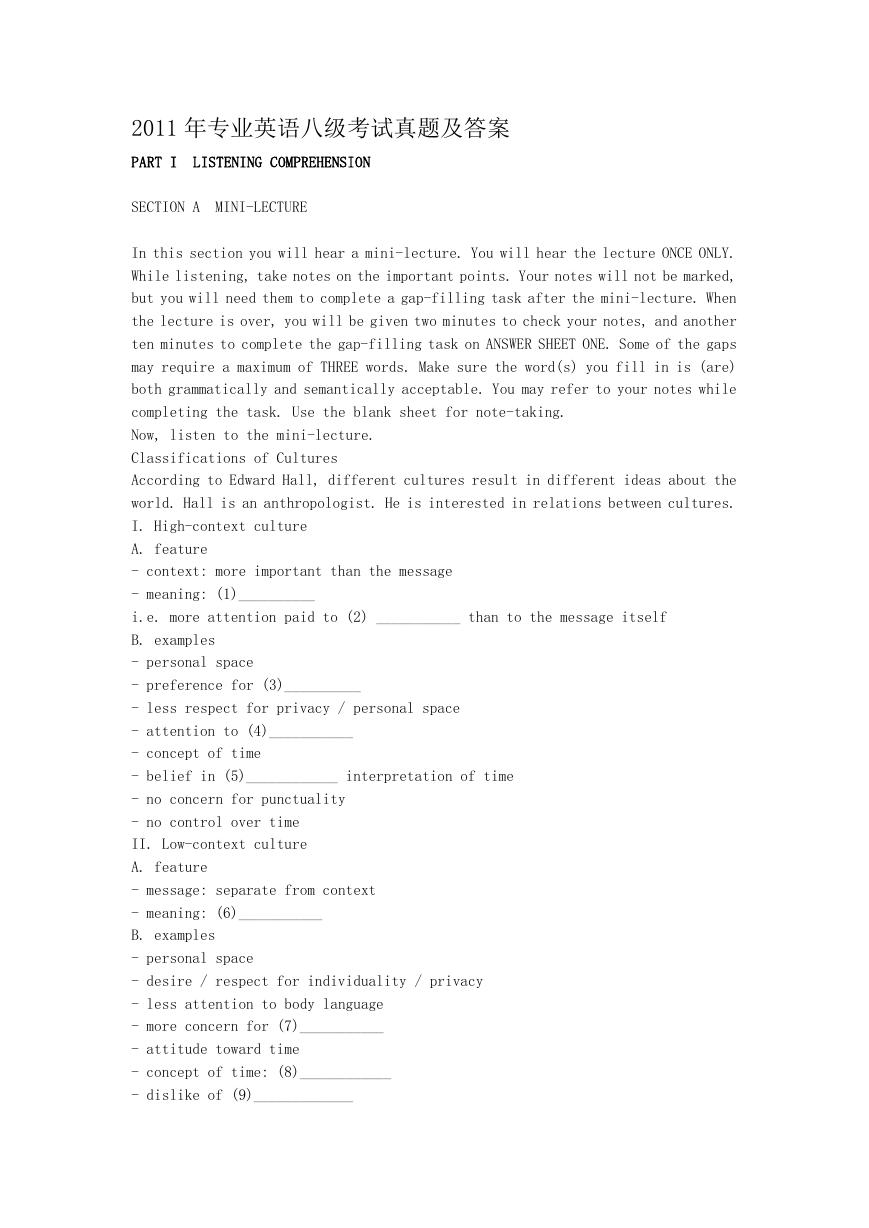

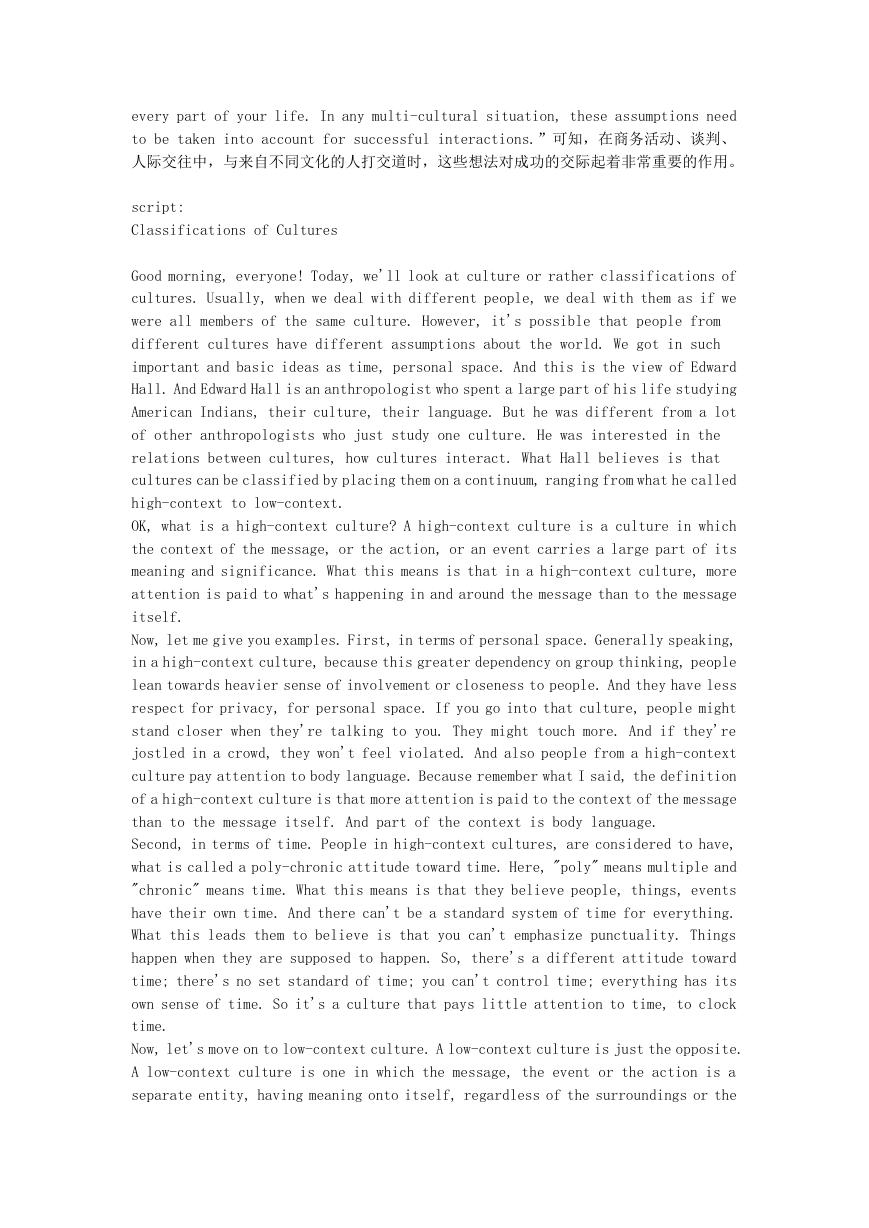
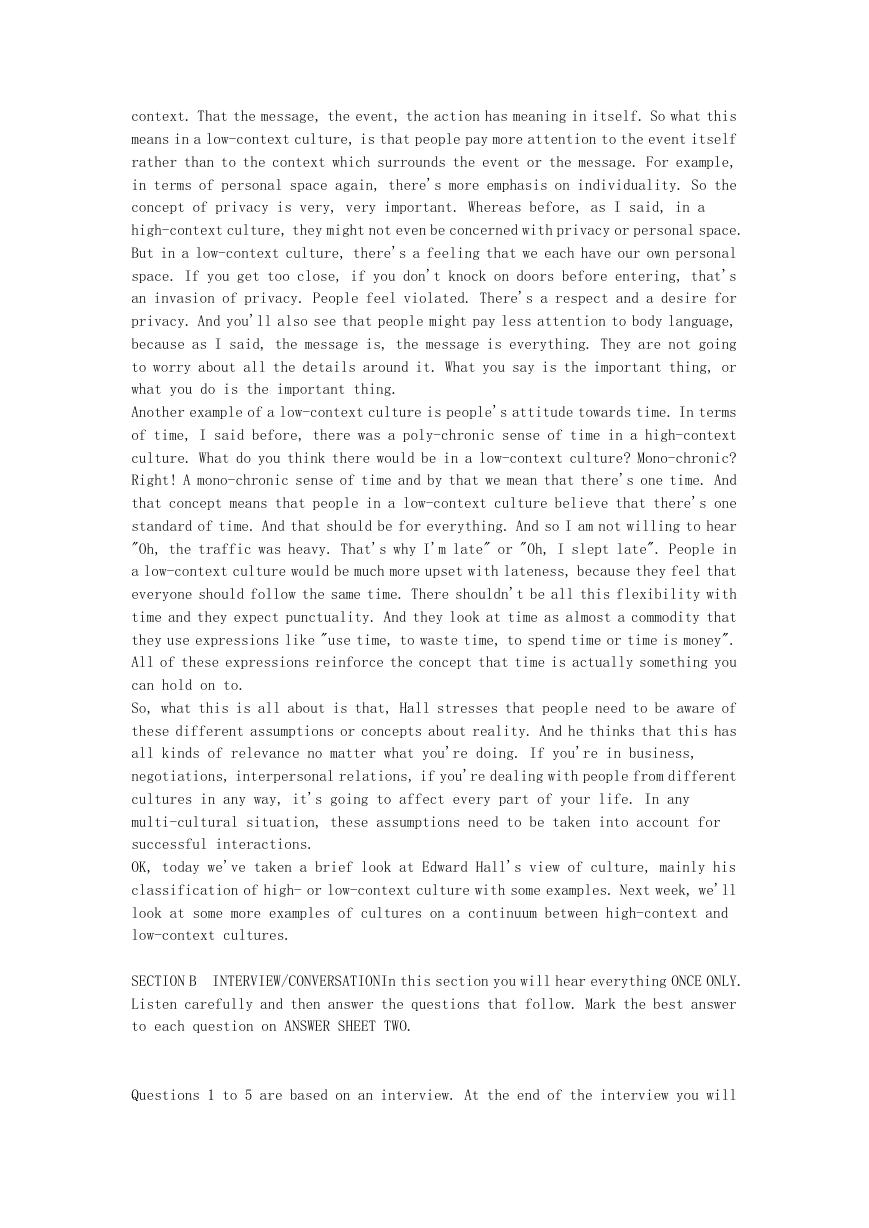


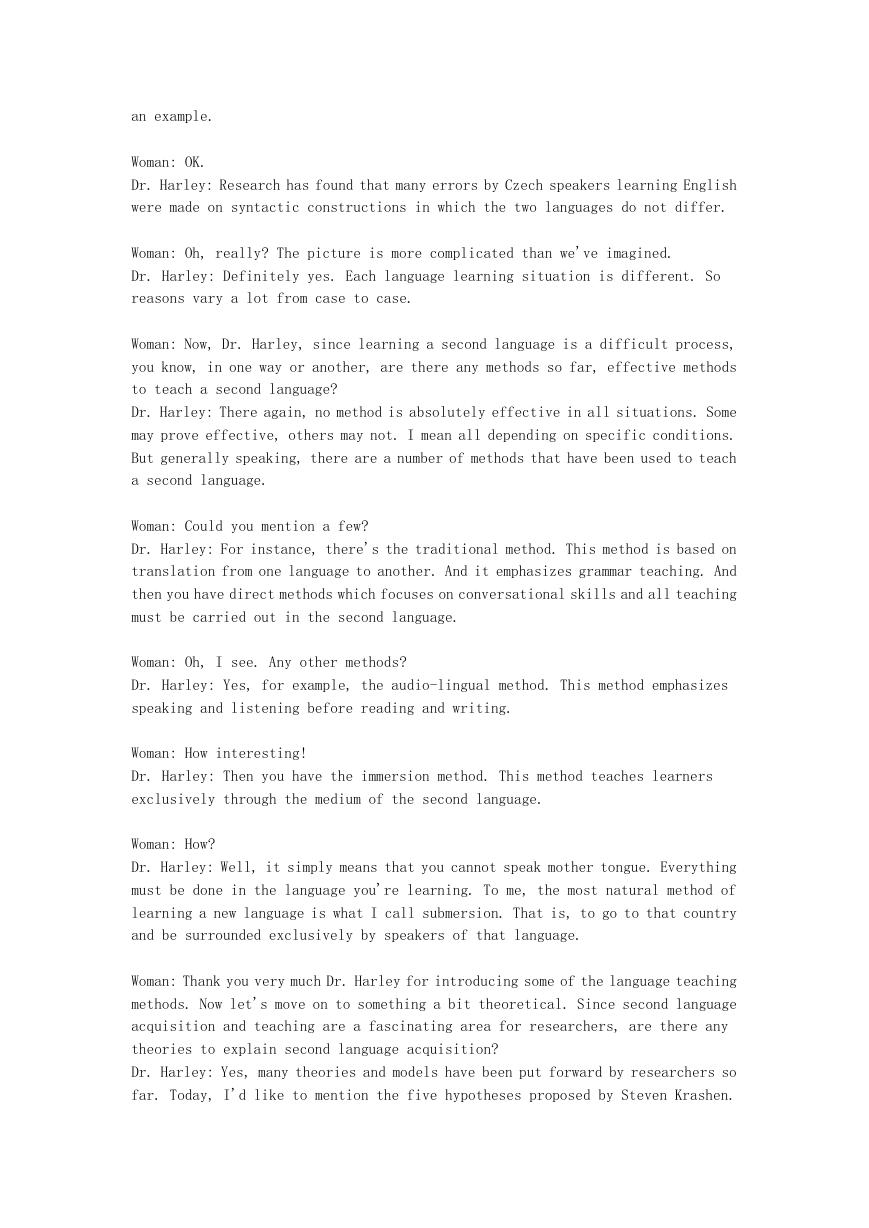
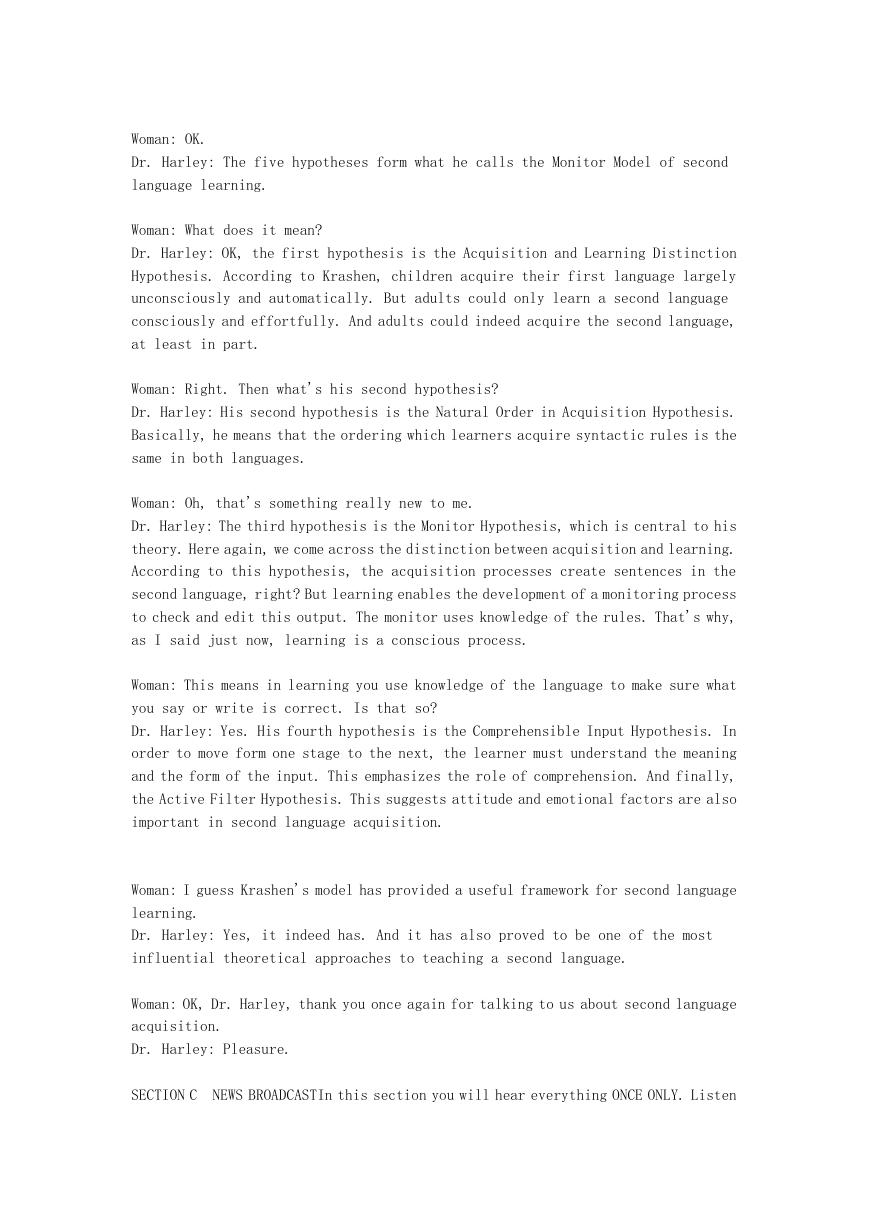








 2023年江西萍乡中考道德与法治真题及答案.doc
2023年江西萍乡中考道德与法治真题及答案.doc 2012年重庆南川中考生物真题及答案.doc
2012年重庆南川中考生物真题及答案.doc 2013年江西师范大学地理学综合及文艺理论基础考研真题.doc
2013年江西师范大学地理学综合及文艺理论基础考研真题.doc 2020年四川甘孜小升初语文真题及答案I卷.doc
2020年四川甘孜小升初语文真题及答案I卷.doc 2020年注册岩土工程师专业基础考试真题及答案.doc
2020年注册岩土工程师专业基础考试真题及答案.doc 2023-2024学年福建省厦门市九年级上学期数学月考试题及答案.doc
2023-2024学年福建省厦门市九年级上学期数学月考试题及答案.doc 2021-2022学年辽宁省沈阳市大东区九年级上学期语文期末试题及答案.doc
2021-2022学年辽宁省沈阳市大东区九年级上学期语文期末试题及答案.doc 2022-2023学年北京东城区初三第一学期物理期末试卷及答案.doc
2022-2023学年北京东城区初三第一学期物理期末试卷及答案.doc 2018上半年江西教师资格初中地理学科知识与教学能力真题及答案.doc
2018上半年江西教师资格初中地理学科知识与教学能力真题及答案.doc 2012年河北国家公务员申论考试真题及答案-省级.doc
2012年河北国家公务员申论考试真题及答案-省级.doc 2020-2021学年江苏省扬州市江都区邵樊片九年级上学期数学第一次质量检测试题及答案.doc
2020-2021学年江苏省扬州市江都区邵樊片九年级上学期数学第一次质量检测试题及答案.doc 2022下半年黑龙江教师资格证中学综合素质真题及答案.doc
2022下半年黑龙江教师资格证中学综合素质真题及答案.doc